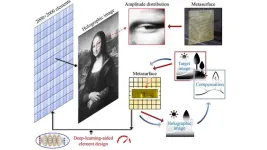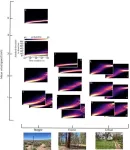(Press-News.org) More than 5,000 planets are confirmed to exist beyond our solar system. Over half were discovered by NASA’s Kepler Space Telescope, a resilient observatory that far outlasted its original planned mission. Over nine and a half years, the spacecraft trailed the Earth, scanning the skies for periodic dips in starlight that could signal the presence of a planet crossing in front of its star.
In its last days, the telescope kept recording the brightness of stars as it was running out of fuel. On Oct. 30, 2018, its fuel tanks depleted, the spacecraft was officially retired.
Now, astronomers at MIT and the University of Wisconsin at Madison, with the help of citizen scientists, have discovered what may be the last planets that Kepler gazed upon before going dark.
The team combed through the telescope’s last week of high-quality data and spotted three stars, in the same part of the sky, that appeared to dim briefly. The scientists determined that two of the stars each host a planet, while the third hosts a planet “candidate” that has yet to be verified.
The two validated planets are K2-416 b, a planet that is about 2.6 times the size of the Earth and that orbits its star about every 13 days, and K2-417 b, a slightly larger planet that is just over three times Earth’s size and that circles its star every 6.5 days. For their size and proximity to their stars, both planets are considered “hot mini-Neptunes .” They are located about 400 light years from Earth.
The planet candidate is EPIC 246251988 b — the largest of the three worlds at almost four times the size of the Earth. This Neptune-sized candidate orbits its star in around 10 days, and is slightly farther away, 1,200 light years from Earth.
“We have found what are probably the last planets ever discovered by Kepler, in data taken while the spacecraft was literally running on fumes,” says Andrew Vanderburg, assistant professor of physics in MIT’s Kavli Institute for Astrophysics and Space Research. “The planets themselves are not particularly unusual, but their atypical discovery and historical importance makes them interesting.”
The team has published their discovery today in the journal Monthly Notices of the Royal Astronomical Society. Vanderburg’s co-authors are lead author Elyse Incha, at the University of Wisconsin at Madison, and amateur astronomers Tom Jacobs and Daryll LaCourse, along with scientists at NASA, the Center for Astrophysics of Harvard and the Smithsonian, and the University of North Carolina at Chapel Hill.
Data squeeze
In 2009, NASA launched the Kepler telescope into space, where it followed the Earth’s orbit and continuously monitored millions of stars in a patch of the northern sky. Over four years, the telescope recorded the brightness of over 150,000 stars, which astronomers used to discover thousands of possible planets beyond our solar system.
Kepler kept observing beyond its original three-and-a-half-year mission, until May 2013, when the second of four reaction wheels failed. The wheels served as the spacecraft’s gyroscopes, helping to keep the telescope pointed at a particular point in the sky. Kepler’s observations were put on pause while scientists searched for a fix.
One year later, Kepler restarted as “K2,” a reworked mission that used the sun’s wind to balance the unsteady spacecraftin a way that kept the telescope relatively stable for a few months at a time — a period called a campaign. K2 went on for another four years, observing over half a million more stars before the spacecraft finally ran out of fuel during its 19th campaign. The data from this last campaign comprised only a week of high-quality observations and another 10 days of noisier measurements as the spacecraft rapidly lost fuel.
“We were curious to see whether we could get anything useful out of this short dataset,” Vanderburg says. “We tried to see what last information we could squeeze out of it.”
By eye
Vanderburg and Incha presented the challenge to the Visual Survey Group, a team of amateur and professional astronomers who hunt for exoplanets in satellite data. They search by eye through thousands of recorded light curves of each star, looking for characteristic dips in brightness that signal a “transit,” or the possible crossing of a planet in front of its star.
The citizen scientists are especially suited to combing through short datasets such as K2’s very last campaign.
“They can distinguish transits from other wacky things like a glitch in the instrument,” Vanderburg says. “That’s helpful especially when your data quality begins to suffer, like it did in K2’s last bit of data.”
The astronomers spent a few days efficiently looking through the light curves that Kepler recorded from about 33,000 stars. The team worked with only a week’s worth of high-quality data from the telescope before it began to lose fuel and focus. Even in this short window of data, the team was able to spot a single transit in three different stars.
Incha and Vanderburg then looked at the telescope’s very last, lower-quality observations, taken in its last 11 days of operation, to see if they could spot any additional transits in the same three stars — evidence that a planet was periodically circling its star.
During this 11-day period, as the spacecraft was losing fuel, its thrusters fired more erratically, causing the telescope’s view to drift. In their analysis, the team focused on the region of each star’s light curves between thruster activity, to see if they could spot any additional transits in these less data-noisy moments.
This search revealed a second transit for K2-416 b and K2-417 b, validating that they each host a planet. The team also detected a similar dip in brightness for K2-417 b in data taken of the same star by NASA’s Transiting Exoplanet Survey Satellite (TESS), a mission that is led and operated by MIT. Data from TESS helped to confirm the planet candidate around this star.
“Those two are pretty much, without a doubt, planets,” Incha says. “We also followed up with ground-based observations to rule out all kinds of false positive scenarios for them, including background star interference, and close-in stellar binaries.”
“These are the last chronologically observed planets by Kepler, but every bit of the telescope’s data is incredibly useful,” Incha says. “We want to make sure none of that data goes to waste, because there are still a lot of discoveries to be made.”
This research was supported, in part, by MIT, NASA, and the University of Wisconsin Undergraduate Academic Awards.
###
Written by Jennufer Chu, MIT News Office
Paper: “Kepler’s Last Planet Discoveries: Two New Planets and One Single-Transit Candidate from K2 Campaign 19”
https://academic.oup.com/mnras/article-lookup/doi/10.1093/mnras/stad1049
END
A telescope’s last view
Astronomers discover the last three planets the Kepler telescope observed before going dark.
2023-05-30
ELSE PRESS RELEASES FROM THIS DATE:
An algorithm for sharper protein films
2023-05-30
Proteins are biological molecules that perform almost all biochemical tasks in all forms of life. In doing so, the tiny structures perform ultra-fast movements. In order to investigate these dynamic processes more precisely than before, researchers have developed a new algorithm that can be used to evaluate measurements at X-ray free-electron lasers such as the SwissFEL more efficiently. They have now presented it in the journal Structural Dynamics.
Sometimes, when using the navigation system while travelling by car, the device will locate you off the road for a short time. This is due to the inaccuracy ...
4,000-year-old plague DNA found – the oldest cases to date in Britain
2023-05-30
Researchers at the Francis Crick Institute have identified three 4,000-year-old British cases of Yersinia pestis, the bacteria causing the plague – the oldest evidence of the plague in Britain to date, reported in a paper published today in Nature Communications.
Working with the University of Oxford, the Levens Local History Group and the Wells and Mendip Museum, the team identified two cases of Yersinia pestis in human remains found in a mass burial in Charterhouse Warren in Somerset and one in a ring cairn monument in Levens in Cumbria.
They took small skeletal samples from 34 individuals across the ...
The making of a Mona Lisa hologram
2023-05-30
WASHINGTON, May 30, 2023 – Holograms are often displayed in science fiction as colorful, life-sized projections. But what seems like the technology of the future is actually the technology of the present, and now it has been used to recreate the Mona Lisa.
In Applied Physics Reviews, by AIP Publishing, researchers from Tianjin University, the Beijing Institute of Technology, Rowan University, the University of Missouri, Qingdao University, Shijiazhuang Tiedao University, and Beijing Jiaotong University developed an acoustic metasurface-based holography technique that uses a deep learning algorithm to generate and iteratively ...
How insects track odors by navigating microscale winds
2023-05-30
WASHINGTON, May 30, 2023 -- How do flying insects like important pollinators locate odor sources in the great outdoors, despite encountering highly variable wind conditions? They use odor plumes — which travel like smoke and form when the wind blows odor molecules from their source — to track down sources such as flowers or pheromones.
But wind tunnels are typically unable to replicate realistic outdoor wind conditions. In Physics of Fluids, by AIP Publishing, University of Nevada at Reno researchers decided to explore microscale wind conditions in various outdoor environments to better understand what flying insects might experience while tracking odor plumes.
Authors ...
Sleep health before SARS-CoV-2 infection and risk of long COVID
2023-05-30
About The Study: The findings of this study that included 1,979 women indicate that healthy sleep measured prior to SARS-CoV-2 infection, both before and during the COVID-19 pandemic, may be protective against post–COVID-19 condition (PCC), also known as long COVID. Future research should investigate whether interventions on sleep health may prevent PCC or improve PCC symptoms.
Authors: Siwen Wang, M.D., of the Harvard T. H. Chan School of Public Health in Boston, is the corresponding author.
To access the embargoed study: ...
Association between heart attack and cognition
2023-05-30
About The Study: In this study of 30,465 adults without myocardial infarction (MI; heart attack), stroke, or dementia, overall, incident MI was not associated with an acute decrease in global cognition, memory, or executive function at the time of the event compared with no MI. The rate of decline in global cognition, memory, and executive function was significantly faster over the years for adults with an MI event compared with those without an MI. These findings suggest that prevention of MI ...
Volunteering, health, and well-being of children and adolescents
2023-05-30
About The Study: Using survey data from across the United States, researchers found that volunteering was associated with higher odds of excellent or very good health and flourishing in children and adolescents, and with lower odds of anxiety in adolescents and behavioral problems in children and adolescents.
Authors: Kevin Lanza, Ph.D., of the Michael & Susan Dell Center for Healthy Living in Austin, Texas, is the corresponding author.
To access the embargoed study: Visit our For The Media website at this link https://media.jamanetwork.com/
(doi:10.1001/jamanetworkopen.2023.15980)
Editor’s ...
Use of metabolic and bariatric surgery among youth
2023-05-30
About The Study: Use of and access to metabolic and bariatric surgery (MBS) have increased among U.S. youth and among most racial and ethnic groups. Compared with 2015-2019, MBS use in youths increased significantly in 2020-2021 during the first 2 years of the COVID-19 pandemic. In contrast, MBS rates in adults decreased in 2020.
Authors: Sarah E. Messiah, Ph.D., of the University of Texas Health Science Center at Houston School of Public Health—Dallas Campus, is the corresponding author.
To access the embargoed study: Visit our For The Media website at this link https://media.jamanetwork.com/
(doi:10.1001/jamapediatrics.2023.0803)
Editor’s ...
Racial, ethnic, and language disparities in identifying and mitigating central line–associated bloodstream infections
2023-05-30
About The Study: The results of this study of 8,269 pediatric patients show disparities in central line–associated bloodstream infection rates for Black patients and patients who speak a language other than English that persisted after adjusting for known risk factors, suggesting that systemic racism and bias may play a role in inequitable hospital care for hospital-acquired infections. Stratifying outcomes to assess for disparities prior to quality improvement efforts may inform targeted interventions to improve ...
Philosophy aligns with economics on how to value future generations in climate policy
2023-05-30
A survey of philosophers finds they broadly agree with economists on the best way of valuing the environment of the future in policy decisions made now – although for different reasons.
In a new study published in Nature Climate Change, environmental economists including the University of Exeter’s Professor Ben Groom found consensus between the two academic disciplines over an aspect of climate policy known as the ‘social discount rate’, with philosophers offering support for a rate of 2% - a value predominantly backed by economists, and which is in line with UN climate ...
LAST 30 PRESS RELEASES:
Injectable breast ‘implant’ offers alternative to traditional surgeries
Neuroscientists devise formulas to measure multilingualism
New prostate cancer trial seeks to reduce toxicity without sacrificing efficacy
Geometry shapes life
A CRISPR screen reveals many previously unrecognized genes required for brain development and a new neurodevelopmental disorder
Hot flush treatment has anti-breast cancer activity, study finds
Securing AI systems against growing cybersecurity threats
Longest observation of an active solar region
Why nail-biting, procrastination and other self-sabotaging behaviors are rooted in survival instincts
Regional variations in mechanical properties of porcine leptomeninges
Artificial empathy in therapy and healthcare: advancements in interpersonal interaction technologies
Why some brains switch gears more efficiently than others
UVA’s Jundong Li wins ICDM’S 2025 Tao Li Award for data mining, machine learning
UVA’s low-power, high-performance computer power player Mircea Stan earns National Academy of Inventors fellowship
Not playing by the rules: USU researcher explores filamentous algae dynamics in rivers
Do our body clocks influence our risk of dementia?
Anthropologists offer new evidence of bipedalism in long-debated fossil discovery
Safer receipt paper from wood
Dosage-sensitive genes suggest no whole-genome duplications in ancestral angiosperm
First ancient human herpesvirus genomes document their deep history with humans
Why Some Bacteria Survive Antibiotics and How to Stop Them - New study reveals that bacteria can survive antibiotic treatment through two fundamentally different “shutdown modes”
UCLA study links scar healing to dangerous placenta condition
CHANGE-seq-BE finds off-target changes in the genome from base editors
The Journal of Nuclear Medicine Ahead-of-Print Tip Sheet: January 2, 2026
Delayed or absent first dose of measles, mumps, and rubella vaccination
Trends in US preterm birth rates by household income and race and ethnicity
Study identifies potential biomarker linked to progression and brain inflammation in multiple sclerosis
Many mothers in Norway do not show up for postnatal check-ups
Researchers want to find out why quick clay is so unstable
Superradiant spins show teamwork at the quantum scale
[Press-News.org] A telescope’s last viewAstronomers discover the last three planets the Kepler telescope observed before going dark.






